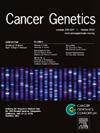62. Characterization of myelodysplastic syndrome (MDS) and acute myeloid leukemia (AML) with KMT2A amplification
IF 1.4
4区 医学
Q4 GENETICS & HEREDITY
引用次数: 0
Abstract
KMT2A amplification is a rare high risk cytogenetic abnormality in myelodysplastic syndrome (MDS) and acute myeloid leukemia (AML), which has been associated with complex karyotype, resistance to chemotherapy and higher frequency in elderly patients. Comprehensive elucidation of cytogenetic signatures in AML/MDS with KMT2A amplification, the subsequent clinical impact, as well as accompanying gene mutation profile would be beneficial for stratified patient care.
Herein, we present karyotyping/fluorescence in situ hybridization (FISH) data on 42 AML/MDS patients with KMT2A amplification, along with next generation sequencing (NGS) results and prognostic information in a subset of patients. The median age at diagnosis was 70 years. The male to female ratio was 1.8 (27:15). The median survival was 45 days. KMT2A amplification was identified by FISH. Chromosome analysis showed complex karyotype in all cases analyzed (n=38). The structural mechanisms associated with KMT2A amplification included homogeneously staining region (n=27), double minutes (n=6) and ring chromosome 11 (n=8). Deletions of 5q (64%) and 17p (62%) were the most common concurrent cytogenetic findings. Additional major concurrent cytogenetic abnormalities included loss of 7q (31%) and gain of chromosome 8 (29%). NGS results were available for 14 cases and TP53 mutation was the most common alteration (n=12). Other mutations were detected in TET2 (n=2), NSD1 (n=2), SAMD9L (n=2), DNMT3A (n=1), U2AF2 (n=1), FLT3 (TKD, n=1), NOTCH1 (n=1) and SMC3 (n=1).
AML/MDS with KMT2A amplification is associated with poor outcome and specific concurrent cytogenetic and molecular abnormalities. Documenting additional data is valuable for improving the treatment landscape in these myeloid neoplasms.
62.骨髓增生异常综合征(MDS)和急性髓性白血病(AML)KMT2A 扩增的特征描述
KMT2A扩增是骨髓增生异常综合征(MDS)和急性髓性白血病(AML)中一种罕见的高危细胞遗传学异常,与复杂核型、化疗耐药和老年患者发病率较高有关。在此,我们展示了42例KMT2A扩增的AML/MDS患者的核型/荧光原位杂交(FISH)数据,以及新一代测序(NGS)结果和部分患者的预后信息。诊断时的中位年龄为 70 岁。男女比例为 1.8(27:15)。中位生存期为 45 天。FISH 鉴定出 KMT2A 扩增。染色体分析显示,所有分析病例(n=38)均为复杂核型。与KMT2A扩增相关的结构机制包括同染色区(n=27)、双分钟(n=6)和环状11号染色体(n=8)。5q(64%)和17p(62%)缺失是最常见的并发细胞遗传学结果。其他主要并发细胞遗传学异常包括 7q 缺失(31%)和 8 号染色体增益(29%)。有 14 个病例的 NGS 结果,TP53 突变是最常见的改变(12 例)。检测到的其他突变包括:TET2(n=2)、NSD1(n=2)、SAMD9L(n=2)、DNMT3A(n=1)、U2AF2(n=1)、FLT3(TKD,n=1)、NOTCH1(n=1)和SMC3(n=1)。KMT2A扩增的AML/MDS与不良预后和特定的并发细胞遗传学和分子异常有关。KMT2A扩增的AML/MDS与不良预后和特定的并发细胞遗传学和分子异常有关,记录更多数据对改善这些髓系肿瘤的治疗前景很有价值。
本文章由计算机程序翻译,如有差异,请以英文原文为准。
求助全文
约1分钟内获得全文
求助全文
来源期刊

Cancer Genetics
ONCOLOGY-GENETICS & HEREDITY
CiteScore
3.20
自引率
5.30%
发文量
167
审稿时长
27 days
期刊介绍:
The aim of Cancer Genetics is to publish high quality scientific papers on the cellular, genetic and molecular aspects of cancer, including cancer predisposition and clinical diagnostic applications. Specific areas of interest include descriptions of new chromosomal, molecular or epigenetic alterations in benign and malignant diseases; novel laboratory approaches for identification and characterization of chromosomal rearrangements or genomic alterations in cancer cells; correlation of genetic changes with pathology and clinical presentation; and the molecular genetics of cancer predisposition. To reach a basic science and clinical multidisciplinary audience, we welcome original full-length articles, reviews, meeting summaries, brief reports, and letters to the editor.
 求助内容:
求助内容: 应助结果提醒方式:
应助结果提醒方式:


